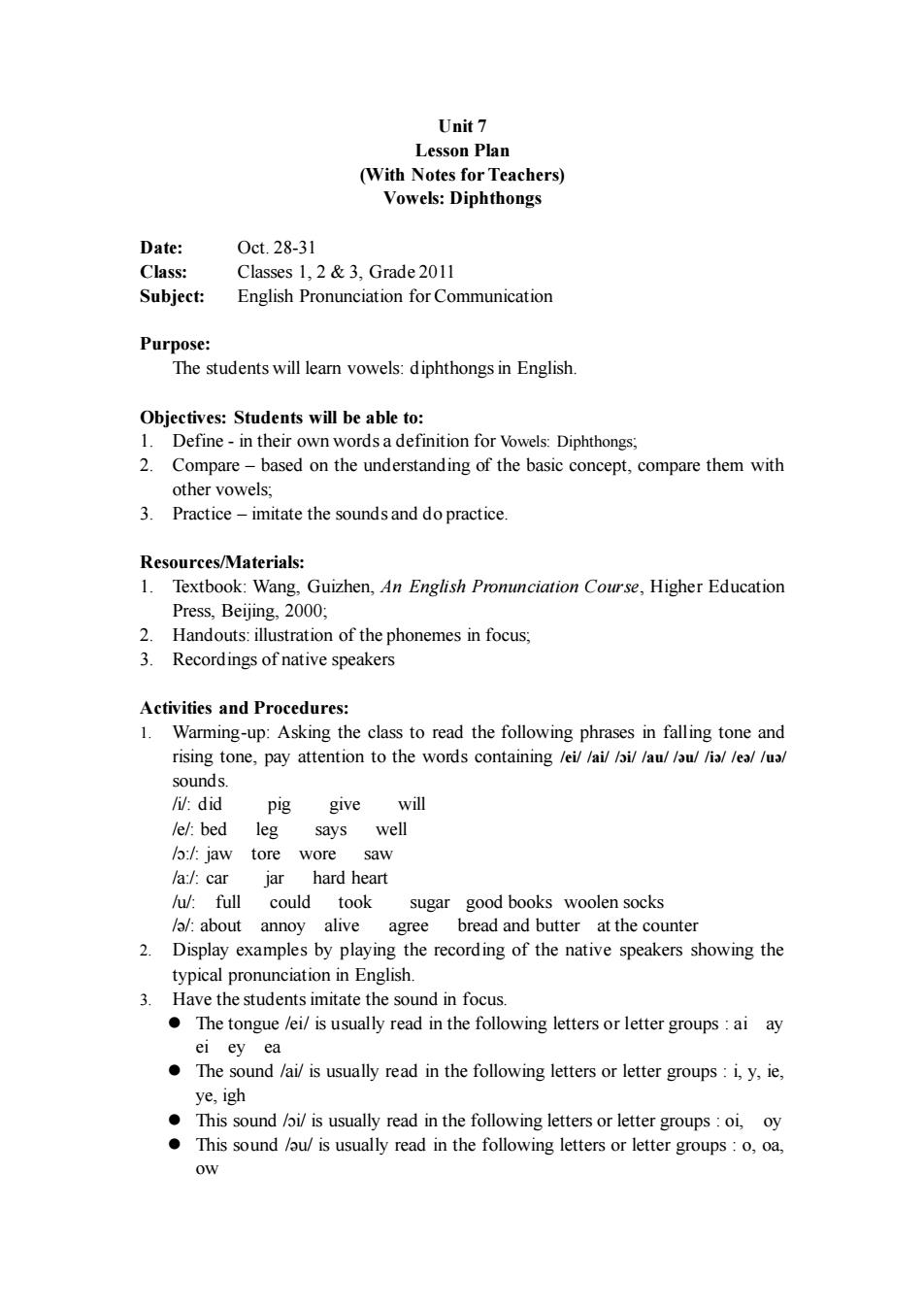正在加载图片...

Unit 7 Lesson Plan (With Notes for Teachers) Vowels:Diphthongs Date: 0ct28.31 Class Classes 1,2&3,Grade 2011 Subject: English Pronunciation for Communication Purpose: The students will learn vowels:diphthongs in English. Objectives:Students will be able to: 1.Define-in their own words a definition for Vowels:Diphthongs; 2.Compare-based on the understanding of the basic concept,compare them with other vowels: 3.Practice-imitate the soundsand do practice. Resources/Materials: 1.Textbook:Wang,Guizhen,An English Pronunciation Course,Higher Education Press,Beijing,2000; 2.Handouts:illustration of the phonemes in focus; Recordings of native speakers Activities and Procedures: 1.Warming-up:Asking the class to read the following phrases in falling tone and rising tone,pay attention to the words containing leil lail ilaul i /e/ nds pig give will /e/:bed leg says well /:/jaw tore wore saw /a:/:car jar hard heart w full could took sugar :about good books woolen socks anno alive d and butter at the unter 2.Display examples by playing the recording of the native speakers showing the typical pronunciation in English. 3.Have the students imitate the sound in focus. The tongue lei/is usually read in the following letters or letter groups:ai ay ey ye,igh This sound /oi/is usually read in the following letters or letter groups:oi,oy This sound /ou/is usually read in the following letters or letter groups:o,oa.Unit 7 Lesson Plan (With Notes for Teachers) Vowels: Diphthongs Date: Oct. 28-31 Class: Classes 1, 2 & 3, Grade 2011 Subject: English Pronunciation for Communication Purpose: The students will learn vowels: diphthongs in English. Objectives: Students will be able to: 1. Define - in their own words a definition for Vowels: Diphthongs; 2. Compare – based on the understanding of the basic concept, compare them with other vowels; 3. Practice – imitate the sounds and do practice. Resources/Materials: 1. Textbook: Wang, Guizhen, An English Pronunciation Course, Higher Education Press, Beijing, 2000; 2. Handouts: illustration of the phonemes in focus; 3. Recordings of native speakers Activities and Procedures: 1. Warming-up: Asking the class to read the following phrases in falling tone and rising tone, pay attention to the words containing /ei/ /ai/ /ɔi/ /au/ /әu/ /iә/ /eә/ /uә/ sounds. /i/: did pig give will /e/: bed leg says well /ɔ:/: jaw tore wore saw /a:/: car jar hard heart /u/: full could took sugar good books woolen socks /ә/: about annoy alive agree bread and butter at the counter 2. Display examples by playing the recording of the native speakers showing the typical pronunciation in English. 3. Have the students imitate the sound in focus. ⚫ The tongue /ei/ is usually read in the following letters or letter groups : ai ay ei ey ea ⚫ The sound /ai/ is usually read in the following letters or letter groups : i, y, ie, ye, igh ⚫ This sound /ɔi/ is usually read in the following letters or letter groups : oi, oy ⚫ This sound /әu/ is usually read in the following letters or letter groups : o, oa, ow